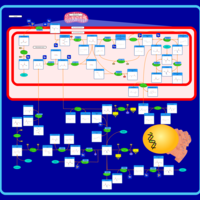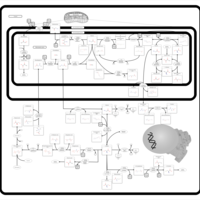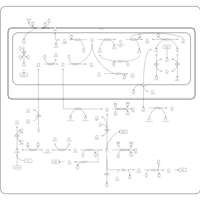| Glycine, serine and threonine metabolism |    |
| Glutathione metabolism |    |
| beta-Alanine metabolism |    |
| Lysine degradation |    |
| Sulfur metabolism |    |
| Purine metabolism |    |
| Tyrosine metabolism |    |
| Tryptophan metabolism |    |
| Valine, leucine and isoleucine degradation |    |
| Nicotinate and nicotinamide metabolism |    |
| Arginine and proline metabolism |    |
| Phenylalanine and Tyrosine Metabolism |    |
| Vitamin B6 Metabolism |    |
| Porphyrin Metabolism |    |
| Caffeine Metabolism |    |
| Methionine Metabolism |    |
| D-Arginine and D-Ornithine Metabolism |    |
| Histidine metabolism |    |
| Aspartate Metabolism |    |
| Riboflavin Metabolism |    |
| Arachidonic Acid Metabolism |    |
| Ibuprofen Action Pathway |    |
| 2-Methyl-3-Hydroxybutryl CoA Dehydrogenase Deficiency |    |
| 3-Hydroxy-3-Methylglutaryl-CoA Lyase Deficiency |    |
| 3-Methylglutaconic Aciduria Type I |    |
| 3-Methylglutaconic Aciduria Type III |    |
| 3-Methylglutaconic Aciduria Type IV |    |
| 5-Oxoprolinuria |    |
| Adenosine Deaminase Deficiency |    |
| Adenylosuccinate Lyase Deficiency |    |
| AICA-Ribosiduria |    |
| Alkaptonuria |    |
| Beta-Ketothiolase Deficiency |    |
| Canavan Disease |    |
| Cystathionine Beta-Synthase Deficiency |    |
| Dihydropyrimidine Dehydrogenase Deficiency (DHPD) |    |
| Gamma-Glutamyltransferase Deficiency |    |
| Glutaric Aciduria Type I |    |
| Guanidinoacetate Methyltransferase Deficiency (GAMT Deficiency) |    |
| Hawkinsinuria |    |
| Histidinemia |    |
| Hypoacetylaspartia |    |
| Maple Syrup Urine Disease |    |
| Methylmalonic Aciduria |    |
| Molybdenum Cofactor Deficiency |    |
| Phenylketonuria |    |
| Prolidase Deficiency (PD) |    |
| Prolinemia Type II |    |
| Purine Nucleoside Phosphorylase Deficiency |    |
| S-Adenosylhomocysteine (SAH) Hydrolase Deficiency |    |
| Tyrosinemia Type I |    |
| Xanthine Dehydrogenase Deficiency (Xanthinuria) |    |
| Methionine Adenosyltransferase Deficiency |    |
| Glycine N-methyltransferase Deficiency |    |
| Non Ketotic Hyperglycinemia |    |
| Propionic Acidemia |    |
| 3-Methylcrotonyl Coa Carboxylase Deficiency Type I |    |
| Isovaleric Aciduria |    |
| Saccharopinuria/Hyperlysinemia II |    |
| Dimethylglycine Dehydrogenase Deficiency |    |
| Sarcosinemia |    |
| Clopidogrel Action Pathway |    |
| Glutathione Synthetase Deficiency |    |
| Methylenetetrahydrofolate Reductase Deficiency (MTHFRD) |    |
| Hypermethioninemia |    |
| Hereditary Coproporphyria (HCP) |    |
| Acute Intermittent Porphyria |    |
| Congenital Erythropoietic Porphyria (CEP) or Gunther Disease |    |
| Porphyria Variegata (PV) |    |
| GABA-Transaminase Deficiency |    |
| Hyperprolinemia Type II |    |
| Hyperprolinemia Type I |    |
| Arginine: Glycine Amidinotransferase Deficiency (AGAT Deficiency) |    |
| Ornithine Aminotransferase Deficiency (OAT Deficiency) |    |
| Lesch-Nyhan Syndrome (LNS) |    |
| Gout or Kelley-Seegmiller Syndrome |    |
| Tyrosinemia Type 2 (or Richner-Hanhart syndrome) |    |
| Tyrosinemia Type 3 (TYRO3) |    |
| Methylmalonate Semialdehyde Dehydrogenase Deficiency |    |
| Citalopram Action Pathway |    |
| Azathioprine Action Pathway |    |
| Mercaptopurine Action Pathway |    |
| Disulfiram Action Pathway |    |
| Thioguanine Action Pathway |    |
| Nicotine Action Pathway |    |
| Cyclophosphamide Action Pathway |    |
| Ifosfamide Action Pathway |    |
| Ethanol Degradation |    |
| Degradation of Superoxides |    |
| Plasmalogen Synthesis |    |
| Dimethylglycine Dehydrogenase Deficiency |    |
| Hyperglycinemia, non-ketotic |    |
| Ureidopropionase Deficiency |    |
| Carnosinuria, carnosinemia |    |
| Tyrosinemia, transient, of the newborn |    |
| Dopamine beta-hydroxylase deficiency |    |
| 5-oxoprolinase deficiency |    |
| Gamma-glutamyl-transpeptidase deficiency |    |
| Hypophosphatasia |    |
| Creatine deficiency, guanidinoacetate methyltransferase deficiency |    |
| Hyperornithinemia with gyrate atrophy (HOGA) |    |
| Hyperornithinemia-hyperammonemia-homocitrullinuria [HHH-syndrome] |    |
| L-arginine:glycine amidinotransferase deficiency |    |
| Xanthinuria type I |    |
| Xanthinuria type II |    |
| 3-hydroxyisobutyric acid dehydrogenase deficiency |    |
| 3-hydroxyisobutyric aciduria |    |
| Isobutyryl-coa dehydrogenase deficiency |    |
| Isovaleric acidemia |    |
| Hyperlysinemia I, Familial |    |
| Hyperlysinemia II or Saccharopinuria |    |
| Sulfite oxidase deficiency |    |
| Monoamine oxidase-a deficiency (MAO-A) |    |
| Adenine phosphoribosyltransferase deficiency (APRT) |    |
| Mitochondrial DNA depletion syndrome |    |
| Myoadenylate deaminase deficiency |    |
| Homocystinuria-megaloblastic anemia due to defect in cobalamin metabolism, cblG complementation type |    |
| Pyridoxine dependency with seizures |    |
| Ibuprofen Metabolism Pathway |    |
| Cyclophosphamide Metabolism Pathway |    |
| Ifosfamide Metabolism Pathway |    |
| Clopidogrel Metabolism Pathway |    |
| Citalopram Metabolism Pathway |    |
| Nicotine Metabolism Pathway |    |
| Nevirapine Metabolism Pathway |    |
| Sorafenib Metabolism Pathway |    |
| Lamivudine Metabolism Pathway |    |
| Thyroid hormone synthesis |    |
| 2-aminoadipic 2-oxoadipic aciduria |    |
| 3-Phosphoglycerate dehydrogenase deficiency |    |